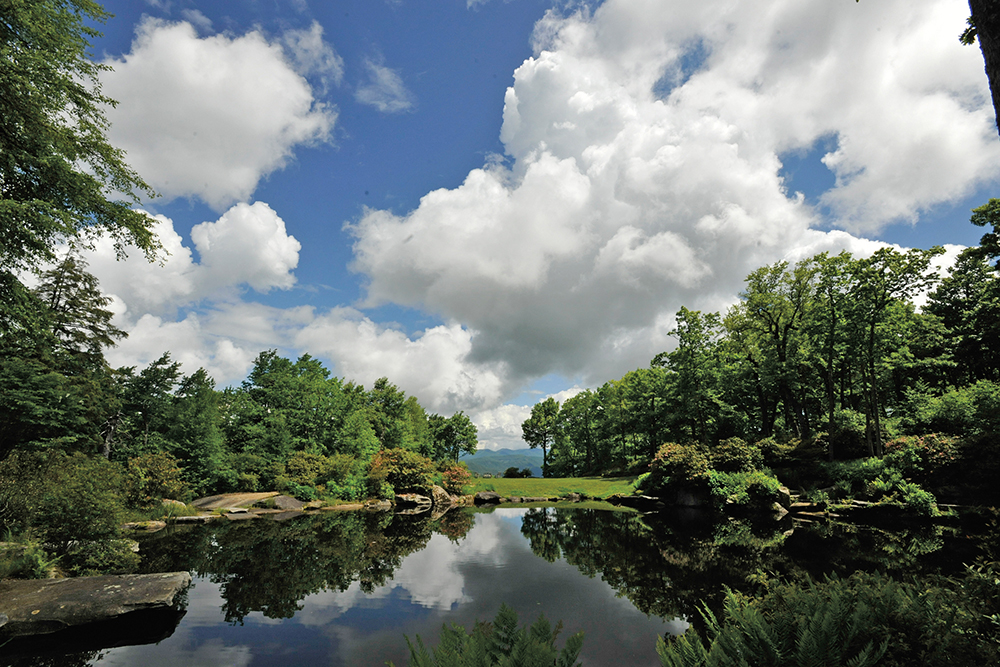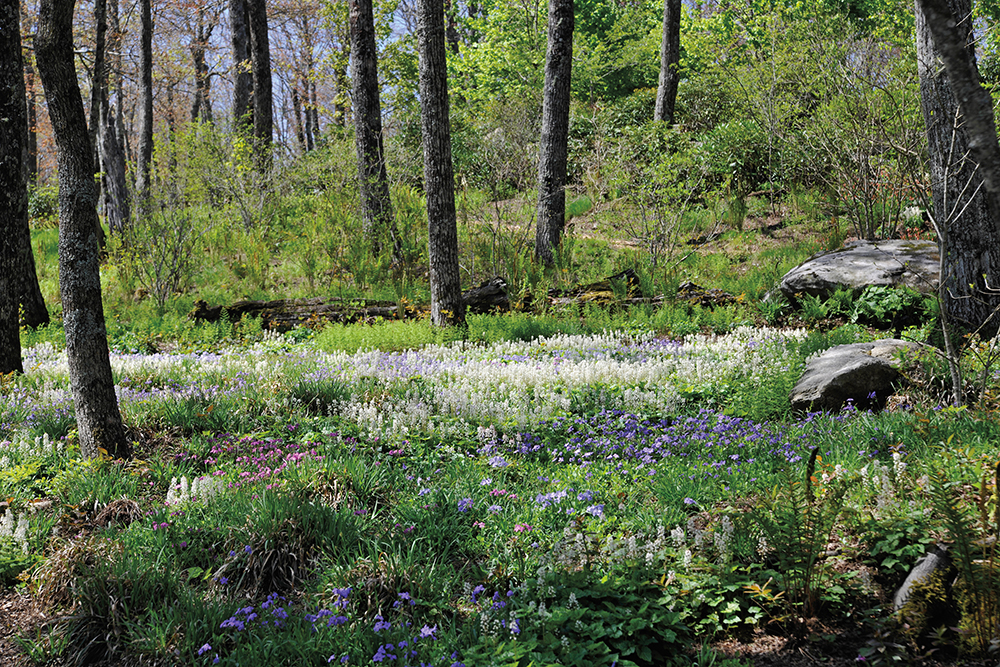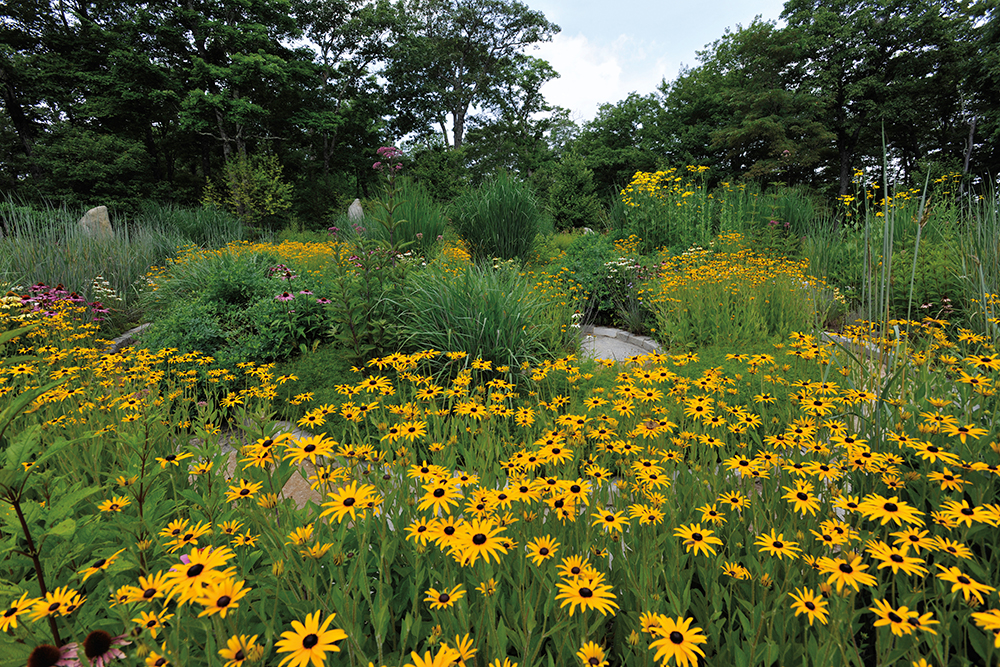Southern Highlands Reserve
Lake Toxaway, North Carolina

Lake Toxaway, approximately fifty miles southeast of Asheville, now surrounded by summer homes with docks and boat houses dotting the shoreline, was created at the turn of the last century, the first artificial lake built in the Appalachian Mountains. The tallest of the mountains that cradle this long and inviting lake is Toxaway Mountain, where, near its top, Southern Highlands Reserve perches some 4,500 feet above sea level. Along the slow-going, miles-long approach, breathtaking glimpses of the surrounding Blue Ridge Mountains are framed by masses of native rhododendron, and high up, the endangered red spruce trees appear like sentinels.
Toxaway Mountain and Southern Highlands Reserve reside within the area known as the Blue Ridge Escarpment, a steep mountain drop that forms the transition between the Blue Ridge of the Appalachians to the lower, rolling topography of the Piedmont plateau. The upper boundary coincides with the eastern continental divide. Geologists believe that the basic formation of the highly weathered Appalachians began with mountain building from about 1 billion to 265 million years ago. The Blue Ridge Escarpment is a product of Cenozoic tectonic uplift and the work of erosive waterways some 65 million years ago. The dramatic drop to the Piedmont produces some of the most spectacular waterfalls in the country, as well as thousands of smaller streams and “spray cliffs” that support rare and endangered plants like Carolina star moss. The escarpment transition zone is also home to rare and endangered biota, including mammals such as the northern flying squirrel.

When I visited in March, the trees remained leafless, but spring was stirring: tiny floating colonies of black frog eggs married to cottony clouds of newt eggs floated in the pond; a peregrine falcon sat on a maple branch not thirty feet away from the window at lunchtime, and diminutive white bloodroot blossoms had already emerged along a woodland path. Portions of the forest floor contained drifts of deep bronze and emerald green galax, their leaves as much as four inches in diameter. Twiggy branches of native azaleas were just starting to set buds even though a major snowstorm was predicted to arrive the next day.
What could have been just another site for a vacation home has evolved instead into an educational and research facility, complete with greenhouses, a display garden, and a lodge housing classroom and research stations. The 120-acre site is composed of two distinct areas: the 22-acre Core Park and Chestnut Lodge, which contains the educational research center, and the Woodland Glade, approximately 100 acres that are left natural but lightly managed. Core Park is a landscape architect’s dream: a designed landscape that reflects the native flora and fauna while allowing for human interaction—walking on gently sloping curvilinear pathways, sitting on the edges of the pond, and traversing the Wildflower Labyrinth through hundreds of colorful perennials including baptisia, rudbeckia, and native grasses that put on a dramatic show much of the summer and fall.

In 2002 the Reserve’s founding director, John Turner, assembled a team of local artisans including rock mason Jack Owen to construct the bones of the garden. Over an eight-year period, landscape architect W. Gary Smith’s master plan took shape as paths were laid and water features, boulders, and plants installed. In recent years Kelly Holdbrooks, executive director, has broadened the Reserve’s research and educational focus through partnerships with like-minded public and private institutions and supervises a growing staff. Director of horticulture Eric Kimbrel oversees the plant collection and propagation efforts. Currently, the research center has two major projects: the Digital Plant Database, funded by a grant from the Stanley Smith Horticultural Trust, in which every plant on the site is being documented, and the establishment of the Reserve as a Blue Ridge Heritage Natural Area, work supported by federal grants through the National Park Service. The second of these recognized the Reserve’s ongoing effort to supply seedlings of the endangered red spruce. The research center’s greenhouses are filled with trays of Lilliputian forests that will be grown out in pots and distributed to various entities involved in saving the spruce-fir ecosystem found only at highest elevations in the area.

One of the traits of a successfully designed landscape is how gracefully the “design” disappears and lets the landscape speak for itself. In Gary Smith’s work at the Reserve, the sole grandiosity is the natural majesty of the breathtaking views glimpsed through the trees or at the Viewsite at Vaseyi Pond. Here, looking at the expanse of forest from above, one is tempted to join the crows and birds of prey as they bank on wind currents, soaring in the sky with views to Glassy Mountain in South Carolina, north to Mount Pisgah near Brevard, and farther, to Mount Mitchell, the highest mountain in eastern North America, more than a hundred miles away.
—Melissa Tufts
All photographs courtesy Southern Highlands Reserve.